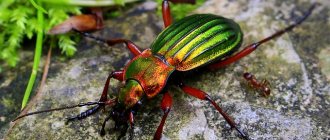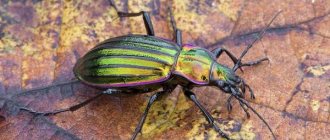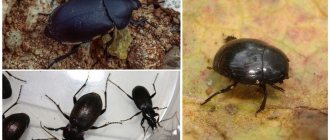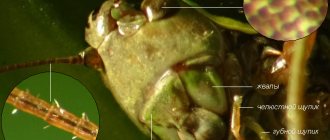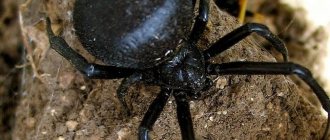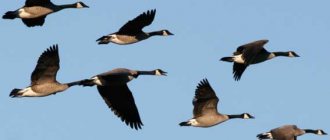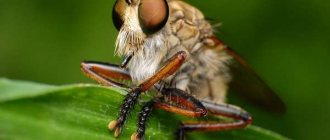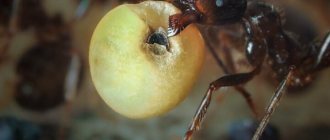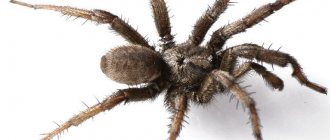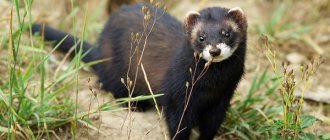The greenhouse grasshopper belongs to the family of cave grasshoppers or raphidiophorids. (Rhaphidophoridae), including 550 species. These are long-moustached orthoptera insects that have lost the ability to fly. Under natural conditions, they are found in dark, damp caves. Using a synanthropic relationship with humans, insects settle in basements, sewers, ventilation shafts, where there is always high humidity and a stable warm temperature. There is enough organic matter here that is suitable food. The greenhouse grasshopper prefers to live in greenhouses and feed on plants.
Reproduction and development of grasshoppers
Grasshoppers of temperate latitudes begin breeding in May - June, tropical species breed regardless of the season. Males attract females with loud trills and a special spermatophore vial consisting of seminal fluid and a sticky nutrient. When mating, the male hangs the vial from the abdomen of the female grasshopper, and she begins to eat the sticky part, while the seminal fluid flows into the female's oviduct.
Laying eggs lasts several hours; in different species of grasshoppers, a female’s clutch can contain from 100 to 1000 eggs. Grasshoppers lay large, oval eggs directly in the ground, attach them to branches and grass stems, and hide them in dry wood or under the bark of trees.
In temperate latitudes, the clutch overwinters in the ground until next year.
Grasshopper - external description, structure, chirping, color, nutrition + 80 photos
- There is probably not a single person on earth who has not heard the chirping of a grasshopper at least once in his life.
- Even kids can distinguish the peculiar sound of a grasshopper from other insects.
Description
The name grasshopper originates from the ancient Russian language - izok, meaning June.
More than 7,000 species of these insects are known, which are found in every corner of our planet except Antarctica. Apparently the harsh Antarctic climate was not to my liking.
Structure
External characteristics of the grasshopper:
- Body flattened on both sides;
- Head with large eyes;
- 3 pairs of legs;
- Mustache;
- Wings.
They move with the help of their front legs, and with the help of their more muscular hind legs, insects jump quite long distances. The length of the jump is 20 times greater than the insect's body.
The length of a grasshopper depends on the species and ranges from 1 to 5 cm, but there are some individuals whose size reaches 15 cm. Which is comparable to the length of a praying mantis.
The whiskers serve as the insect's sense of touch. An interesting fact is that the longer the length of the antennae, the higher the higher place the grasshopper occupies on the hierarchical ladder among its relatives.
- The wings have a direct function and help the grasshopper take off and fly short distances.
- Some subspecies have an additional pair of wings that perform a protective or safety function for the main wings.
Grasshopper chirping
- Any type of grasshopper has a peculiar chirping sound, but in most cases this sound is made by males.
- Only in some types of grasshoppers are females capable of producing musical sounds, because the wings of females are much weaker than those of the opposite sex.
- Due to this feature, females are simply not able to produce such a musical and expressive sound.
The basic wings with which the insect takes off have hard elytra.
In this case, one wing acts as a resonator, and the second acts as a bow.
Due to the vibration of the wings, a wonderful chirping sound is created, which is characteristic of a certain type of grasshopper.
Grasshopper color
The color of the insect will depend on the habitat in which it lives. That is why you can find green, brown and even striped colors.
One of the characteristics of the grasshopper is the location of its ears. They did not have enough space on their heads, like many representatives of other insects. Therefore, the ears are located on the front legs in the area of the lower leg.
In the same place are the eardrums, which perform their direct function. When the front legs are lost, hearing is correspondingly lost. Legs are especially precious to him.
How does a grasshopper live?
The lifestyle directly depends on the type of grasshopper and its characteristic features.
A common green grasshopper has a body length of up to 4 mm. This is believed to be the most common group.
As for orange grasshoppers, they were brought to us from China. You can only see them in greenhouses.
The largest grasshopper is considered to be the Giant Weta. It weighs about 80 grams.
- Ant - records, durability, species, castes, interesting facts + 91 photos
Grasshoppers are not pests for humans and agricultural land. And some peoples have long included these insects in their daily diet.
If a grasshopper feels threatened by a person, it may bite him. The bites received from this insect are quite painful, because it has a powerful jaw.
Some people like the grasshopper's singing, and in order to continue to listen to it constantly, people have come up with an artificial habitat for maintaining a home - insectariums.
Nutrition
Who would have thought, but such a small and charming insect in most cases, depending on the species, is a predator. It selects smaller insects for food.
- However, if the hunt was not successful, he does not mind eating young plants.
Reproduction
The beginning of reproduction depends on the habitat. In temperate climates, lovemaking begins in late spring or early summer. At this time, the males emit loud trills.
- At this point, they have seminal fluid in the form of a capsule, which is necessary for reproduction.
At the moment of reproduction, the male attaches a sticky bait - a capsule - to the female's abdomen. While she eats it, the liquid gradually enters her oviduct.
After fertilization, the female lays eggs on her own, which can contain from 100 to 1000 eggs. Then larvae appear, resembling a small grasshopper.
During growth, the grasshopper molts from 4 to 8 times. After the last molt, the insect waits until its wings get stronger. The insect lives only one season.
Grasshopper photo
Source: https://zelenyjmir.ru/kuznechik/
Peacock grasshopper
This grasshopper received this name because of the pattern on its wings. When raised, they actually vaguely resemble a peacock's tail. The grasshopper uses its bright colors and unusual decoration on its wings as a psychological weapon. If there is danger nearby, the wings rise vertically, imitating the large size of the insect and huge “eyes”.
Adaptation of grasshoppers to their environment
Many animals feed on grasshoppers, and they face death every second. Therefore, they fight for life, using all the opportunities given by nature. The main methods of defense of grasshoppers are protective and dismembering coloration, the ability to hide, jumping legs, spines with which they signal to relatives about approaching danger, and the ability to bite. For example, the leaf grasshopper from Sudan can bite through human skin until it bleeds. But there are also lesser-known types of protection for these insects.
When threatened, some grasshoppers can tear off their legs. The ability of animals to break off body parts is called autotomy. Grasshoppers easily lose one of their hind legs, and sometimes both. Close to the phenomenon of autotomy is the process of self-mutilation - gnawing off limbs in response to irritation. This is especially common in some grasshoppers.
Protective coloring seems to be a simple and primitive way of protection. Grasshoppers also use other, more complex methods of deception. Mimicking leaves is a favorite technique used by many insects. One of the grasshoppers of the species Cycloptera elegans looks very much like a dried leaf. The similarity is enhanced by spots on its wings, reminiscent of a fungal infection of the leaves.
Another grasshopper from the genus Pterochosa, living in America, is similar in color, pattern, and arrangement of veins to a withering and discarded leaf. There are spots on its wings that resemble damage to leaves by leaf miners. This ideal method of copying was called “hyperthemia” (overimitation).
Other species imitate the resemblance to a twig protruding from a trunk, lichen growths on tree trunks. There are grasshoppers that can scare away attackers with a squeal and cause disgust with a drop of regurgitated gastric juice.
Photo credit: gailhampshire, CC BY 2.0
Field grasshoppers
They have a laterally compressed body with a fusiform and slightly compressed abdomen at the top. Field grasshoppers are also lobed and large-headed, often lack simple eyes and have tightly compressed lips. The jaws of insects of the group are well developed.
Green grasshopper
Cannot be larger than 7 centimeters in length. The insect is painted green. The color on the wings is especially rich. There are 2 pairs of them. This is a feature of all grasshoppers. They use the first narrow pair of wings to protect the body when at rest and when jumping. The upper wings are wide and are used for flight.
On the wings of a green grasshopper there may be brown along the edge. Large eyes stand out on the insect's muzzle. They are faceted, that is, they are held on the head by a ring of cuticle - a tough but flexible tissue.
There are subspecies of green grasshoppers . They all hide in the crown of bushes and trees. Therefore, insects do not jump out from under people’s feet. Accordingly, meetings with representatives of the group are rare.
song grasshopper
This is a mini copy of a green grasshopper. The songbird does not grow more than 3.5 centimeters. Another 3 may be on the ovipositor.
The wings of the singing grasshopper end level with the abdomen. Representatives of the green species have wings that protrude significantly.
Gray grasshopper
Grows up to 4 centimeters in length. The grasshopper's appearance matches its name. The abundance of brown spots on a green background makes the insect gray when viewed from a distance. Gray grasshoppers are easy to see. Insects live in field and steppe grasses, easily tolerating the heat.
Due to their prevalence and large size, gray grasshoppers are confused with locusts, which belong to the short antennae suborder. In its name lies the difference between insects.
The antennae of the gray grasshopper are often longer than its body. Locusts have short whiskers. The mechanism of chirping also differs. Locusts make sounds by rubbing their legs together. The grasshopper arches its elytra.
Gray one of the most common types of grasshoppers
Long-nosed grasshopper
Represents the fauna of Europe. The length of the insect does not exceed 6.3 centimeters. The color of the grasshopper is brown-green.
The long-nosed insect is named because of the elongated front part of the muzzle. The grasshopper appears to be equipped with a proboscis.
Grasshopper-leaf
In Latin it is called Elimaea Poaefolia. Among field grasshoppers it has the longest body. It is narrow and green. This allows you to blend in with the blades of grass on which the grasshopper sits.
The leaf grasshopper lives in the Malay Archipelago.
Giant weta
Endemic species, found only in New Zealand. The weta weighs about 70 grams, that is, 2 times more than a sparrow. The length of a well-fed grasshopper reaches 15 centimeters. The rest of the appearance is unremarkable. The insect is colored in beige-brown tones.
The legs of the giant weta are of medium length, the eyes are of medium size, and the mustache is of mediocre length in comparison with the size of the body.
The gigantism of New Zealand grasshoppers is due to the absence of small mammals on the islands. For lack of enemies, the Wets almost reached their size. However, in the 20th century, mammals were introduced to the fields of Zealand. Because of this, the number of giant grasshoppers is declining.
Grasshopper giant weta
Notes
- (English). Orthoptera Species File (Version 5.0/5.0). Retrieved August 13, 2022.
- ↑
- ↑ Pravdin F.N.
Order Orthoptera (Orthoptera) // Animal Life. Volume 3. Arthropods: trilobites, chelicerates, trachea-breathers. Onychophora / Ed. Gilyarova M. S., Pravdina F. N. - 2nd ed., revised. - M.: Education, 1984. - P. 178-180. — 463 p. - ↑ Bei-Bienko G. Ya. Order Orthoptera - Orthoptera // Key to insects of the European part of the USSR. T. I. Lower, ancient winged, with incomplete transformation. / edited by Corresponding member G. Ya. Bey-Bienko. - M.-L.: "Science", 1964. - P. 210. - 936 p. — (Key guides to the fauna of the USSR, published by the Zoological Institute of the USSR Academy of Sciences; issue 84.). — 6300 copies.
- Stanek V. Ya.
Illustrated encyclopedia of insects. - Prague: Artia, 1977. - P. 50. - 560 p. - Striganova B. R., Zakharov A. A.
Five-language dictionary of animal names: Insects (Latin-Russian-English-German-French) / . - M.: RUSSO, 2000. - P. 16. - 1060 copies. — ISBN 5-88721-162-8. - Ilyinskaya M.I.
Pests of greenhouse plants. - M.: Publishing House of the USSR Academy of Sciences, 1963. - 131 p. - ↑ Pests of agricultural crops and forest plantations: In 3 volumes - Vol. 1. Harmful nematodes, mollusks, arthropods / Under the general. ed. V. P. Vasilyeva. Editor of the volume V. G. Dolin. — 2nd ed., rev. and additional - K.: Harvest, 1987. - P. 133. - 440 p.
- ↑ Beloselskaya Z.G., Silvestrov A.D.
Pests and diseases of flower and greenhouse plants. - M.-L.: Selkhozgiz, 1953. - P. 93, 96, 111, 114. - 208 p. - ↑
- ↑ (German). orthoptera.ch. Retrieved August 13, 2022.
- ↑
- ↑ Peter Detzel.
Die Heuschrecken Baden-Württembergs. - Stuttgart: Eugen Ulmer, 1998. - ISBN 3-8001-3507-8. - Akhatov A.K. et al.
Protection of greenhouse and greenhouse plants / edited by A.K. Akhatov and S.S. Izhevsky. - M.: KMK, 2004. - P. 84. - 307 p. — ISBN 5-87317-161-0. - Bey-Bienko G. Ya. et al.
Insects and mites are pests of agricultural crops. T. 1. Insects with incomplete transformation / ed. volumes: Kryzhanovsky O. L., Danzig E. M.. - L.: Nauka, 1972. - P. 16. - 323 p. - Adelung N.
Beitrag zur Kenntnis der palaarktischen Stenopelmatiden (Orthoptera, Locustodea) (German) // Extrait L' Annuaire Musee Zoologique L' Academie Imperiale Science St. Petersburg. - 1902. - Vol. 7. - P. 55-75. - (English). Orthoptera Species File (Version 5.0/5.0). Retrieved August 17, 2022.
Lots of questions
Indeed, I would like at least some specific words from experts about whether this fact actually took place. There is only an old photograph in which the largest grasshopper (photo attached) hangs lifelessly with its antennae down, its hind legs (although in relation to the photograph one should say antennae and paws) are doubtfully clamped by the frail hand of a brave hunter. If this fact took place, then where was the public looking? Did the Red Book appear after this incident? There are more questions than answers. The photo looks like an obvious hoax - Americans are generally known forgers. Every criticism is valid. Indeed, where is the shadow of the grasshopper? Why is the posture of a successful hunter so relaxed, because the load is considerable? Someone even pointed out the fact that in 1937 “baseball caps” were not worn. As for the size, there are clear facts that they do not correspond to the life of this type of insect.
Home maintenance
Many people may think that the singing grasshopper is an excellent pet to keep at home, but actually they are right.
If you are not bothered by the fact that the pet will not live long, and will chirp without a female in a pair, then feel free to drag it home. It is not difficult to make a terrarium for a singing grasshopper; any container with sufficient ventilation, approximately 40x30x30 in size for 2-3 singing grasshoppers, will do.
It is recommended to sprinkle sawdust at the bottom of the container, and place a jar of wet peat in the corner, into which the female will lay larvae. Any substrate will do, even soil from the street, with the proviso that you will then have to look for the eggs of the singing grasshopper by hand. You should also place various driftwood and sticks in the container to increase the usable area and allow the grasshopper to climb branches.
The singing grasshopper should be fed with insects; at home, you can feed it with food insects such as marbled or Turkmen cockroaches; you should also offer greens, in the form of various plants from the street.
Song grasshopper eggs along with the substrate should be removed at the end of August and placed in the refrigerator until the end of February. Then they are removed and the little singing grasshoppers are waited for to emerge.
Control measures
Methods to combat this insect have not yet been sufficiently developed. For preventive and exterminatory purposes, the following is recommended: it is advisable to locate tobacco plantations away from egg-laying sites (thrush and virgin areas) of the green grasshopper; treatment of the shag field and surrounding area with internal poisons; placement of bait with poison in pest habitats. This will require 30–60 kg of bran, 24 liters of water, 0.8–1.2 kg of arsenous soda.
Video
https://youtube.com/watch?v=F9rC3L_y9zo
Sources
- https://www.animals-wild.ru/nasekomye/1489-oranzhereynyy-kuznechik.htmlhttps://ru.wikipedia.org/wiki/Grasshoppershttps://vdbr.ru/pevchij-kuznechik-opisanie.htmlhttps:// stopvreditel.ru/rastenij/selxoz/kuznechik-zelenyj.htmlhttps://nashzeleniymir.ru/grasshopper
Giant Weta
You can meet this giant on the islands of New Zealand. It was the isolation of the territories that allowed the insect to grow to its modern size.
Endemics are often distinguished by gigantism; it will not be possible to meet this grasshopper in any other place except the New Zealand archipelago.
The color of the insect is brown, its dimensions reach 10 cm in length, its legs are equipped with sharp spines, which the insect uses exclusively for defense.
Life cycle
The males' nuptial chirping and mating occur in June. The males' singing continues until deep darkness. Males and females mate multiple times. Oviposition occurs in July-August. Females lay eggs in the turf in small groups of 6-8 pieces. In total, one female can lay 48-72 eggs. In nature, embryonic diapause can last more than 3 years. The eggs overwinter. The larvae emerge from the eggs in late April-early May. Larvae of the second and third instars are found in mid-May, the fourth instar - at the end of May. The larvae of the last fifth instar and the first adults are found in early June.
Varieties and botanical description
There are 4 types of crickets: house, field, stem and ant. Let's take a closer look at them.
Brownie
The house cricket has a gray-yellow color with brown streaks, and has 3 stripes of the same color on its head. Individuals measure up to 25mm. They have a chitinous layer that protects it from moisture loss and some environmental influences.
The antennae of these insects perform the function of touch, the two front pairs of limbs are responsible for hearing, and the two rear ones are responsible for moving by jumping.
But if there are too many insects, this will lead to great harm to cultivated plants.
Field
Basically, these crickets live in meadows and fields, but can also be found in pine forests. They live in the ground at a depth of about 20 cm.
They have dimensions close to the size of a brownie, but have a black color with a glossy tint. You can find brown individuals with orange splashes. They also have antennae and eyes.
Stem
This type of cricket has another name: “eastern trumpeter”. This species is smaller in size than its family. Their size is only about 1.3 cm, the color of the stem cricket is green, with a black stripe on the belly.
This species got its name because it lays eggs in plant stems. Each clutch contains no more than 2-3 eggs. In mid-summer, larvae emerge from the eggs, which then turn into adults.
Formic
Ant crickets are small in size even compared to their relatives. They grow to only 5 mm, have no wings, and look like cockroaches. This species cannot make sounds.
They nest next to ants and spend the winter in anthills. Their larval development cycle from egg laying is about 2 years and is divided into five stages.
Fat Pallas / Deracantha onos
The uniqueness of the species lies in the fact that its representatives, during evolution, have lost the ability to jump. This feature makes this species completely defenseless, especially against human agricultural activities (grazing livestock, land development).
These colorful insects feed mainly on cereals, but cannibalism is possible in captivity.
The sizes of Tolstunov range from 40–50 mm in males to 50–60 mm in females. This species is named after the first scientist who described it, P. Pallas.
3
Main types of grasshoppers
Today, about 20 varieties of grasshoppers are known, the most famous of them:
- Singing grasshopper.
- Variety of Shelkovnikova.
- Gray grasshopper.
- Ashy shrub.
- Steppe rack.
Each of these representatives has its own habitat, as well as a number of anatomical features.
Fat Pallas
The dimensions of this species are 5 cm in females and 6 cm in males. A unique feature of the fat man is that in the process of evolution he completely forgot how to jump.
This makes it defenseless against predators and people who tirelessly conquer the insect’s habitat by plowing the land and grazing livestock.
The colors of these grasshoppers are varied, but variegated individuals are more common. They feed mainly on plant foods; in times of acute shortage, they can also devour their fellow creatures.
The largest grasshopper in the world
When we hear “grasshopper,” a character from everyone’s favorite children’s song immediately comes to mind—a cute insect with a green body and long, jumping limbs. In fact, the grasshopper is not as harmless as it might seem at first glance. He is not averse to dining on small insects, or even even entering into a fight with a frog in order to taste the tasty delicacy. And the sizes of grasshoppers of different species differ noticeably from each other.
Ueta (from Greek - “terrible grasshopper”) is how New Zealanders call amazing insects from the order Orthoptera. The body length of some representatives of the families Rhaphidophoridae and Anostostomatidae reaches 10-20 cm, and this does not include paws and antennae! The largest grasshopper in the world weighs up to 70 grams, which is approximately equal to the weight of the sparrow we all know. It is worth noting, however, that the females of this insect are significantly inferior in size and weight to the males.
Secrets of the one sitting in the grass
Externally, grasshoppers are very similar to locusts. Main differences: locust whiskers are short, females do not have an ovipositor. Grasshoppers do not form a herd form; they bring more benefit to agriculture than harm.
The most typical representative of this genus for our latitudes is the green grasshopper (Locusta viridissima L.). The spectacular large insect lives where there is high grass. The protective coloring makes it invisible - when the grasshopper does not move or sing, it is not easy to notice. Along the sides of the insect’s body there is a lighter stripe, similar to a grass stem, which camouflages it even better. The female differs from the male in its larger size and the presence of a saber-shaped ovipositor.
Female green grasshopper
The grasshopper is secretive and timid. Disturbed, it either falls into the thick grass or jumps, opens large transparent wings in the jump and flies away from its pursuer. It is quite difficult to observe grasshoppers in nature, so much of their life remains “behind the scenes” for people, including their feeding habits. Meanwhile, this creature can transform in an amazing way: from a vegetarian it turns into an agile predator, capable of catching a victim twice its size.
Greenhouse grasshoppers
They are hunchbacked and stocky. The body of greenhouse grasshoppers is shortened, but females have a long ovipositor. Representatives of the genus are also distinguished by long legs and mustaches. The latter reach 8 centimeters.
Chinese greenhouse grasshopper
A little less than 2 centimeters in length. The shortened body surrounded by long, thin legs makes the insect look like a spider.
The Chinese grasshopper is painted brown. There are dark spots. They, like the rest of the body, are covered with short, silky hairs. The insect sheds them, along with its chitinous shell, about 10 times during its life. This is a record for grasshoppers.
Far Eastern grasshopper
Included in the grasshopper species of Russia . The insect is otherwise called a cave insect, since it settles not only in greenhouses, but also in karst rock cavities.
The Far Eastern grasshopper is medium-sized, brown-gray in color. The insect is nocturnal. This distinguishes the species from most grasshoppers.
Lifestyle
Living exclusively in heated rooms, insects are active all year round. They are found in botanical gardens, greenhouses, and greenhouses. They are nocturnal and hide in crevices or plant debris during daylight hours. Shy ones, hearing an extraneous sound, jump a considerable distance. Chinese greenhouse grasshoppers are polyphagous. They feed on parts of plants (leaves, young shoots) and small insects, larvae caught in greenhouses.
Fat guy
The species is European, on the verge of extinction, included in the species of large grasshoppers . Males of the species are 8 cm long. The length of females is 6 centimeters.
The names of grasshoppers are often based on their appearance. A fat man, for example, looks plump, even fat. Due to this, the visually black-brown body of the insect appears shorter. Volume is also added by sharp keels on the sides of the grasshopper's pronotum.
Fat grasshopper
Greenhouse grasshoppers
They are hunchbacked and stocky. The body of greenhouse grasshoppers is shortened, but females have a long ovipositor. Representatives of the genus are also distinguished by long legs and mustaches. The latter reach 8 centimeters.
Lifestyle and features
The natural green color is designed to help the grasshopper camouflage among plants and herbs. Large green individuals can often be found in garden plots, fields and meadows, and in desert areas - in river valleys and on the edges of riparian forests. In Central Asian territories, the insect prefers to huddle high in the mountains, hiding among gorges with green, lush grass.
Both the adult and the larva have a green color, on the body of which small black spots can occasionally be found. The body length of an adult varies between 29-37 mm, and its antennae resemble long bristle-like antennae of a reddish color. The antennae of insects are often longer than the body, on which the front and rear pairs of wings are located.
The hind wings are usually hidden under the front wings, the length of which is approximately 2 times the length of the body. The head is slightly elongated, on which there are oval, bulging eyes. The pronotum in the upper section can be convex or flat. The mouthparts of grasshoppers are gnawing.
Females can be distinguished from males by the presence of a saber-shaped ovipositor, compressed on the sides. The auditory organs on the body are represented by membranes, which are located in the area of the shins of the front legs on both sides. Speaking about the description of individuals, it should be noted that males have a peculiar chirping organ - it is formed by a resonating membrane and a stridulatory part.
Green grasshoppers have a solitary lifestyle; they are capable of excellent flight and jumping, and the jump is often much longer than the insect itself. They do not have a permanent home - they constantly live in the grass, on bushes or trees, and in the heat they can spend the whole day among the greenery, leaving the shelter early in the morning.
The chirping sounds are produced by vibration and are amplified by the raising of the wings - males make these sounds to attract females and to warn other males that the territory is occupied.
Grasshoppers as a food product
Grasshoppers are a common food product in many countries around the world. They contain a lot of protein and other nutrients. For Europeans, eating insects is something repulsive and disgusting. However, many peoples of Asia and Africa enjoy this tasty and healthy food.
Grasshopper dishes:
- fried dry insects taste like peanuts,
- grasshoppers fried in oil with garlic,
- grasshopper fritters,
- marinated grasshoppers baked on skewers,
- deep-fried grasshoppers.
In order to catch a sufficient number of insects, it is enough to go out onto the green lawn with a net. The energy value of a grasshopper is about 150 kilocalories per 100 grams of product. The average protein content is higher than in meat and is 25 grams.
In the near future, grasshoppers, locusts, crickets and worms may well become a familiar and widespread product. Already, some manufacturers are adding insect flour to their products, thereby increasing their nutritional value.
Hind leg of a grasshopper
The grasshopper's hind legs are adapted for jumping, with thick thighs and long tibiae (hence why they are called jumping insects).
The legs are attached to the chest from below, usually sit in the coxal cavities and consist of a coxa, trochanter, femur, tibia and tarsus. The coxa and trochanter provide the necessary mobility to the leg. The thigh is the largest and strongest part of the leg, as it has powerful muscles. Its articulation with the lower leg is called the knee, and the part adjacent to it is called the knee. The tibia is approximately equal in length to the thigh, but thinner, equipped with spines, and spurs at the top. Jumps can reach a height of up to 80 cm, and if wings help, the distance they cover in one jump reaches 10 meters.
Green, but not a grasshopper
There is an insect that is so similar to a grasshopper that an inexperienced eye will not immediately distinguish one from the other. These are locusts. The life of a locust takes place in two phases. At the moment of “loneliness” the fillies take on a protective color and lead a relatively calm lifestyle. In the second stage they form flocks. This is the main difference between a locust and a grasshopper: an insect similar to a grasshopper is a herbivore.
Flocking together in flocks, the grasshopper's short-whiskered counterparts are capable of destroying hundreds of hectares of crops in a few hours. Such flocks move at an alarming speed, and no means have yet been invented to combat them. What else distinguishes a thunderstorm from a grasshopper? Short mustache, shorter than that of the master of serenades, hind legs, powerful forelimbs. Locusts do not jump, which is why their legs are weaker. Finally, the grasshopper destroys insects, saving people from them, and the locust destroys farmland, causing harm.
Devil's spiny grasshopper / Panacanthus cuspidatus
This insect with a terrifying name and appearance reaches a length of 60–70 mm.
The grasshopper's body is bright green, and each limb is covered with sharp, most often yellow, spines. In case of danger, the spiny devil rises sharply to its hind limbs, pushing its forelimbs forward. He swings them until the enemy retreats.
Despite its hostility towards enemies, it is quite peaceful and calm, feeding mainly on the seeds of flowering plants.
5
Relationships with a person
There are known cases of mass reproduction of insects in urban sewers. They moved through the sewer system into the apartments of the townspeople, causing fear among the residents. In the hunched body with huge limbs, few recognized the grasshopper. Females scared people more than males. The cause was a saber-shaped ovipositor, mistaken for a poisonous sting. Despite its unusual appearance, the greenhouse grasshopper is absolutely safe for humans. If it has settled in the house, then you can drive the insect away by reducing the humidity level. It is enough to block his access to water and eliminate all pipe leaks.
Tachycinesasynamorys causes more problems in greenhouses and greenhouses than in the home. It feeds on plants and becomes a dangerous pest when multiplying in large numbers. Grasshoppers are voracious; adults and larvae eat flowers, vegetables and ornamental plants together. The insect is included in the list of pests of orchids, chrysanthemums, and ferns growing in closed ground.
What does a grasshopper eat?
For the most part, the grasshopper is a predator, mercilessly destroying clutches of insects, aphids, caterpillars, butterflies, beetles, ticks, and small locusts in its path. If you are unlucky with hunting, unpretentious insects are content with young shoots of plants. The food of some species of grasshoppers is exclusively plant-based: grasshoppers eat grass or leaves of trees (for example, birch and chestnut trees), and some of them are noted as serious agricultural pests. Unlike the same related locusts, which eat farmers' crops, grasshoppers are more beneficial. For example, they help get rid of the Colorado potato beetle, which has taken a fancy to potato fields.
In conditions of autonomous maintenance and lack of nutrients, grasshoppers have even been observed in cannibalism, that is, eating their own kind. A simple experiment showed that if you put several of these insects in a closed jar and leave them without food for a couple of days, the group will eventually suffer losses among their relatives.
It may seem surprising, but if the grasshopper does not receive its “dose” of protein and salts from ordinary food, then it does not disdain to feed on feces and carrion, and also eats its weaker relatives with appetite.
Distribution area
Natural range: East Asia (China, Korea, Japan). At the end of the 19th century, this grasshopper with plants was brought to Europe and North America, where it was noted as a synanthropic species. In the European part of Russia, it was first described in 1902 from the Botanical Garden of St. Petersburg. Later it was found in Kyiv (Botanical Garden named after Academician A. A. Fomin), as well as in greenhouses in Moscow, Kirov and other cities. Under the name Tachycines coreanus Yamasaki, 1969 in 1999 it was first found in the Russian Far East in Vladivostok. In 2005, it was first found in the Middle Volga region (Penza).
In the introduced parts of the range they are found in heated and humid areas: greenhouses, greenhouses, botanical gardens, zoos, as well as sewers and basements of residential buildings, from where they can penetrate into apartments through ventilation systems. Outside their borders, in temperate countries, it is found only in hot summers. In Adjara and Georgia it penetrated into the countryside, where it is found in bathhouses, kitchens and basements.
Curious grasshoppers
The huge number of varieties of such insects indicates their undoubted diversity. This also applies to their appearance. Mentioning different types of grasshoppers , we have already encountered very unusual ones, for example, the leaf grasshopper or the spiny devil. But there are other, no less amazing representatives of the alluring world of small creatures. They will be discussed further.
Multicolored grasshopper
Such noticeable insects, although not capable of flight and without wings at all, are found in Colombia. But nature generously enriched them with a variety of colors, which corresponds to the nature of the area where they live.
Their body is covered with patterns of blue, red, white, as well as other numerous tones and their shades, combined into intricate patterns. Moreover, the color of the members of this variety exists in many variations. There is a subspecies with individuals that have an orange-black outfit.
Pink grasshopper
Such grasshoppers really exist. But they do not belong to any species, because they are victims of a genetic mutation, one might even say a disease. With it, the production of red pigment in the insect sharply exceeds the norm.
This cannot be considered a positive change. All grasshoppers, as we have seen, strive to be invisible, but these, on the contrary, stand out. Due to this, their chances of survival are significantly reduced. Pink specimens of grasshoppers have been recorded several times in England, as well as on islands near the Australian continent.
Peacock grasshopper
However, bright colors can play into the grasshopper’s hands. Another example of this is a variety that was discovered quite recently, just over ten years ago, and found in the tropical forests of Peru. The colors of such creatures make them look like fallen leaves. But that's not all.
They have huge wings, which they spread in moments of danger, making them look like bright butterflies. But the most important thing is the pattern on the wings. Among other designs, it has circles that exactly resemble the eyes of a bird of prey, from which any enemy comparable in size to grasshoppers will run away.
The similarity is even more intensified and becomes frightening when the grasshopper begins to jump. Such dances terrify enemies, instilling the idea that an insidious pursuer is chasing them.
Grasshopper rhinoceros
Another variety, the appearance of the representatives of which exactly copies the leaf, albeit a little withered and torn, which only adds naturalness. Here all that remains is to once again admire the perfect art of nature.
And the shape of the “leaf” is realistically similar, slightly curved. And the point sticking out in front imitates a handle, but also resembles a horn. This is where the name came from. Such grasshoppers have thin and inconspicuous, but extremely long antennae.
Giant weta
The types of grasshoppers in the photo provide an opportunity to get acquainted in detail with the external appearance of these creatures. And now it’s time to introduce the largest, and also ancient, grasshopper that exists on the planet. It is a resident of New Zealand, and is found exclusively there, that is, it is considered endemic.
Such a creature has apparently lived on Earth since time immemorial, ever since giants were not at all uncommon in the world of insects. Today, such creatures, in exceptional cases, are capable of reaching sizes of 15 cm, although not all of them are this size.
The color of the giant grasshopper can be beige-brown or brown. A distinctive feature of such insects is the presence of sharp, large spines on their hind limbs. This is a weapon for protection against enemies and a good means of obtaining food.
The antiquity and preservation of this species to this day is explained by the absence on its native islands of active enemies capable of feeding on such huge insects. And therefore, until a certain point, the giant wetas lived quietly and remained untouched.
But with the development of civilization, everything changed. People brought small mammals to the islands. Some of them spread quite widely and considered giant grasshoppers quite desirable food for themselves. Therefore, the number of unique giants began to decline. It's a pity.
Meaning
Greenhouse tropical and ornamental plants are damaged, including orchids (eat leaves and sprouts), cyclamen (eat shoots), chrysanthemums (eat cuttings), ferns (eat unexpanded leaves), as well as garden crops. They mainly harm succulent sprouts. To combat the pest, it is recommended to use succulent plants treated with insecticides. They pose no direct danger to humans, are not poisonous and do not bite.


